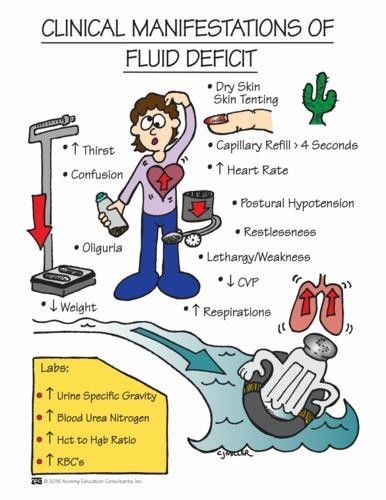A nurse is caring for a client who is postoperative and is experiencing nausea and vomiting. The nurse should identify which of the following findings as indications that the client has fluid volume deficit. (Select all that apply.)
Full bounding pulse
Cool extremities
Moist crackles in the lungs
Orthostatic hypotension
Flat neck veins
Correct Answer : B,D,E
A: A full bounding pulse is a sign of increased fluid volume or fluid overload, not fluid volume deficit.
B: Cool extremities can be an indication of decreased peripheral perfusion, which may occur in fluid volume deficit.
C: Moist crackles in the lungs are an indication of fluid volume excess or pulmonary congestion, not fluid volume deficit.
D: Orthostatic hypotension, which is a drop in blood pressure when changing from lying to standing, can be a sign of fluid volume deficit due to inadequate blood volume.
E: Flat neck veins are an indication of decreased venous return and can occur in fluid volume deficit.

Nursing Test Bank
Naxlex Comprehensive Predictor Exams
Related Questions
Correct Answer is B
Explanation
A: Standing facing the center of the bed at the client's side is not the most stable position for moving a client, as it does not provide a wide base of support.
B: Placing feet apart with one foot in front of the other provides a wide base of support and allows the nurse to use their body weight to assist in the movement, making this the correct action.
C: Keeping knees and hips straight while bending at the waist toward the client can lead to back strain and does not utilize the stronger leg muscles, making it an incorrect action.
D: Encouraging the client to keep their legs straight and remain still may be helpful, but it does not directly involve the nurse's actions in moving the client, so it is not the correct answer to this question.
Correct Answer is D
Explanation
A. A urine specific gravity of 1.015 is within the normal range (1.005–1.030). While fluid volume excess may lead to a lower specific gravity due to urine dilution, this value does not indicate fluid overload and is considered normal.
B. A hematocrit level of 42% is within the normal range for adults (men: 38–50%, women: 35–45%). Hematocrit levels tend to decrease in fluid volume excess due to hemodilution, but this value does not suggest fluid overload.
C. A urine pH of 6.5 is within the normal range (4.5–8.0). Urine pH reflects the acid-base balance rather than fluid status and is not a reliable indicator of fluid volume excess.
D. A BUN level of 5 mg/dL is below the normal range (10–20 mg/dL). In fluid volume excess, the dilution of blood plasma can lead to decreased BUN levels. This low BUN value, in conjunction with clinical symptoms, supports the diagnosis of fluid volume excess.
Whether you are a student looking to ace your exams or a practicing nurse seeking to enhance your expertise , our nursing education contents will empower you with the confidence and competence to make a difference in the lives of patients and become a respected leader in the healthcare field.
Visit Naxlex, invest in your future and unlock endless possibilities with our unparalleled nursing education contents today
Report Wrong Answer on the Current Question
Do you disagree with the answer? If yes, what is your expected answer? Explain.
Kindly be descriptive with the issue you are facing.
